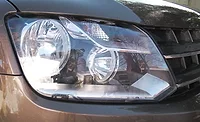Plate-Like Pigments in Automotive Paints: a Review


Second, if the plate-like particles are based on, or contain, selectively absorbing materials the interaction with light is based on absorption and reflection. As a result, both the reflected and the transmitted light are colored. Plate-like iron oxides (e.g., BASF Paliocrom Copper L 3000 and L3101) and plate-like phthalocyanine (BASF Paliochrom Blue Gold L 5000) belong to this group.








The solution is to strengthen the reflection - and thus the chroma - by surrounding the non-absorbing dielectric with a very thin semi-transparent layer of highly reflective material.
By doing this, the extent of extinction and enhancement of particular wavelengths is efficiently increased. These OV pigments therefore exhibit deep colors, high gloss and a high color dependence on the viewing angle (color flop). So far, OV pigments of the Fabry-P?t type and OV pigments with inner reflector are on the market. The Fabry-Parot type has a dielectric core of low refractive material, which is surrounded by a semitransparent reflector.5

This example shows the color flop in the Al/SiO2/Fe2O3-system.


In addition to these interference pigments micro titanium dioxide must not be forgotten. This ultra fine material (particle size ca. 10-50 nm) is found more frequently in the basecoats of two-coat metallic systems since its introduction in 1987, as it is also possible to obtain a color flop with this product.10



Conclusion
Plate-like pigments have visual, physical and chemical advantages. Applications for these pigments include not only cars but also building exteriors, furniture, and cosmetics. Therefore, the forensic scientist is becoming confronted with plate-like pigments more frequently. Several new plate-like pigments will come onto the market soon, including OV pigments of the Fabry-P?t type, inner reflector type, liquid crystal type and holographic pigments.A concept for classifying and identifying plate-like pigments by applying a combination of analytical methods has been published. 11
References
1 Novinski, S.J.; Nowak, P.J.; Venturini, M.T. Pearlescent Pigments in High Performance Coatings. Presented at Intertech Conference; 1997 Oct. 27-29, Chicago2 Esselborn, R.; Franz, K.D.; Hofmeister, F. Color Styling with Lustre Effect Pigments in Multi-Layer Systems. Presented at the Eurocoat 85 Congress; 1985, Stra?burg
3 Franz, K.D.; Emmert, R.; Nitta, K. Interference Pigments. Kontakte (Darmstadt). 1992; 2:3-14. ISSN 0172-8717
4 Teaney, S.; Denne, I. Color Formulations with Iriodin(r) / Afflair(tm) Pigments for Automotive Coatings. Kontakte (Darmstadt). 1992; 2:46-55. ISSN 0172-8717
5 Schmid, R.; Mronga, N.; Radtke, V; Seeger, O. Optically Variable Lustre Pigments - Optisch variable Glanzpigmente. Farbe & Lack. 1998;104:44-48.
6 Sharrock, S.R.; Schuel, N. New effect pigments based on SiO2 and Al2O3 flakes. European Coatings J. 2000;1. http://www.coatings.de/papers-archive.cfm.
7 Kuntz, R.F.; BrAckner, H.D. Pearl Lustre Pigments with Improved Properties. Presented at the 3rd NArnberg Congress; 1995 March 13-15, NArnberg
8 Anon. Holographic Pigments - Add New Dimensions to Paint. PCI. 1997:48-49.
9 Heinlein, J.; Kasch, M. Pigments Offer Color Effects Matched Only by Nature. PCI. 1999:58-75.
10 Winkler, I.; Proft, B. Vor UV schAtzen und selektiv blaues Licht streuen - Eigenschaften und Anwendungen von nanokristallinem Titandioxid. Farbe & Lack. 2001;107:28-36.
11 Stoecklein, W. The Analysis of New Plate-Like Pigments in Automotive Coatings. PCI. 2001: 48-65.
Looking for a reprint of this article?
From high-res PDFs to custom plaques, order your copy today!




